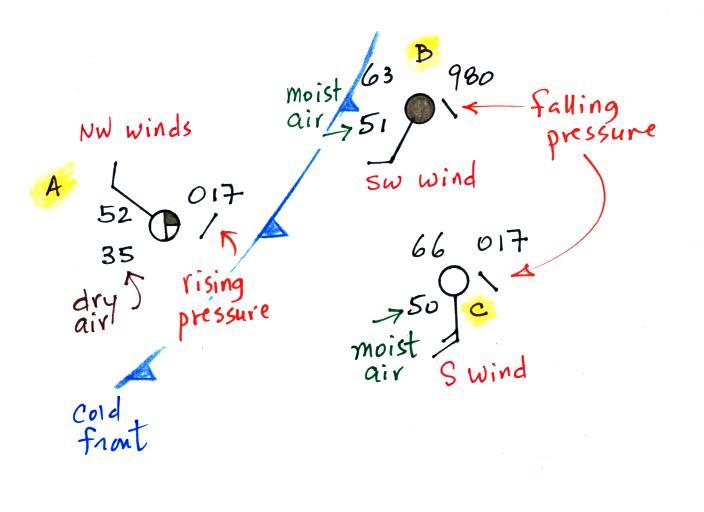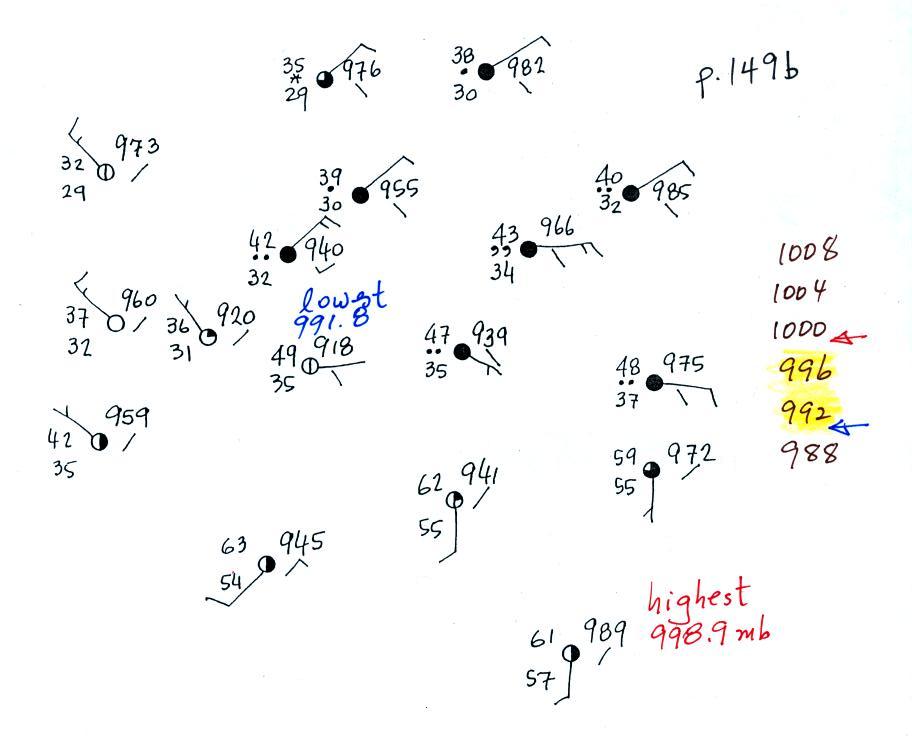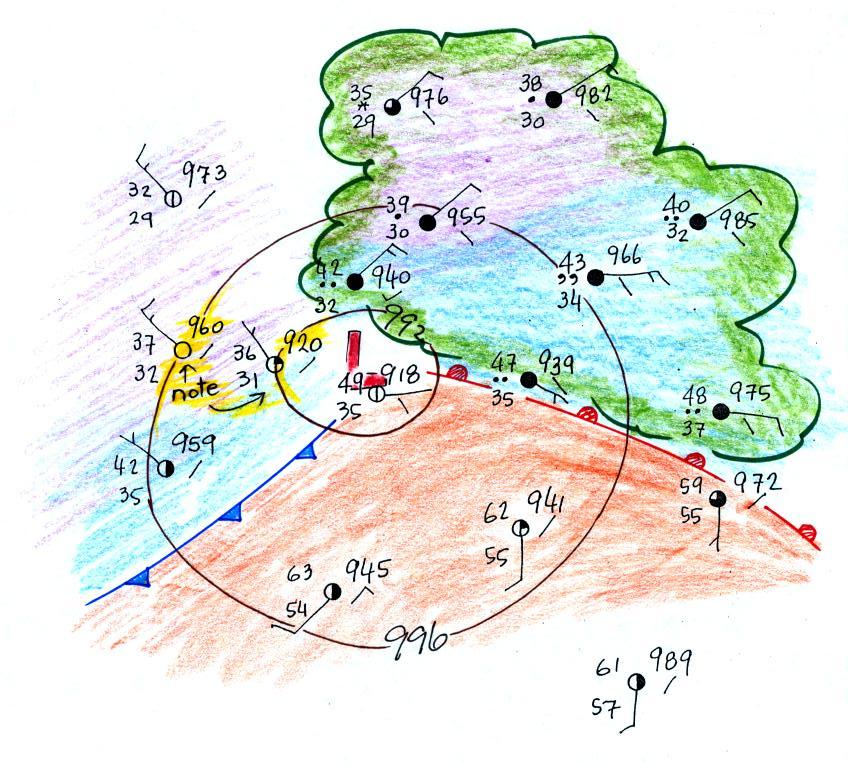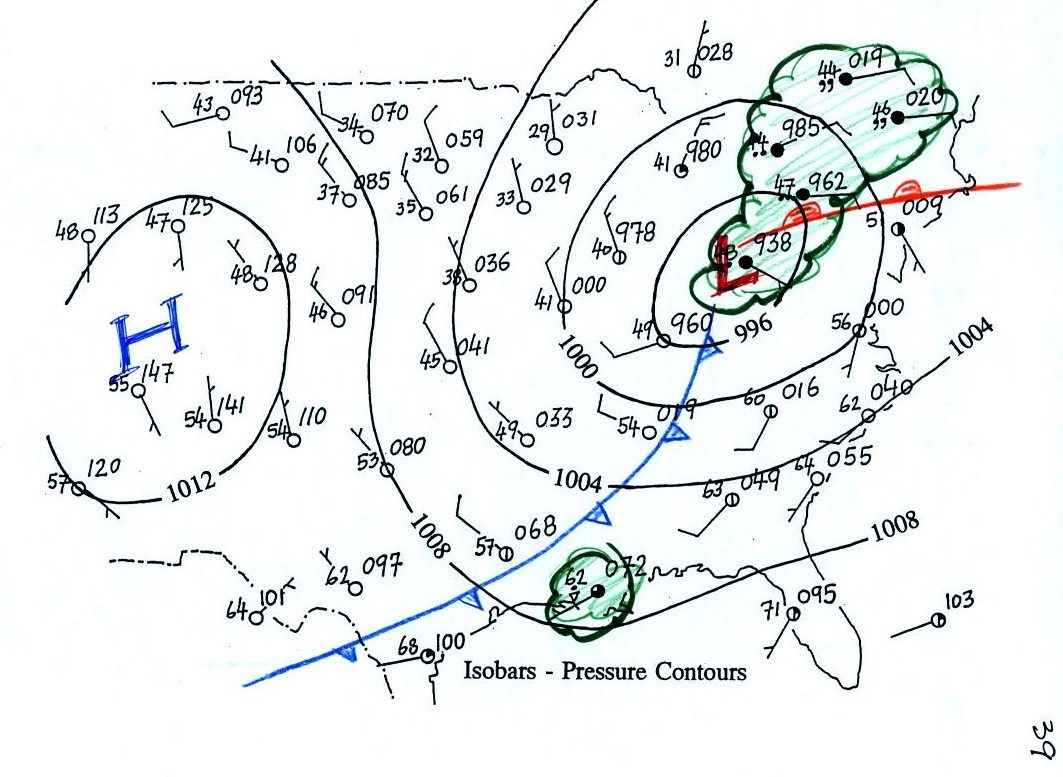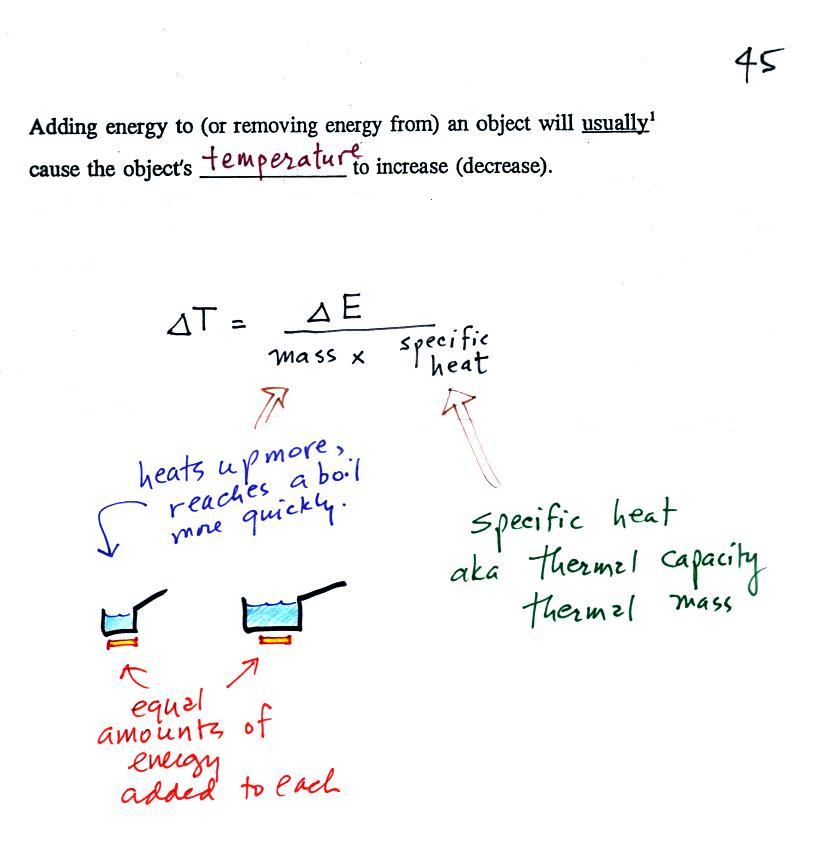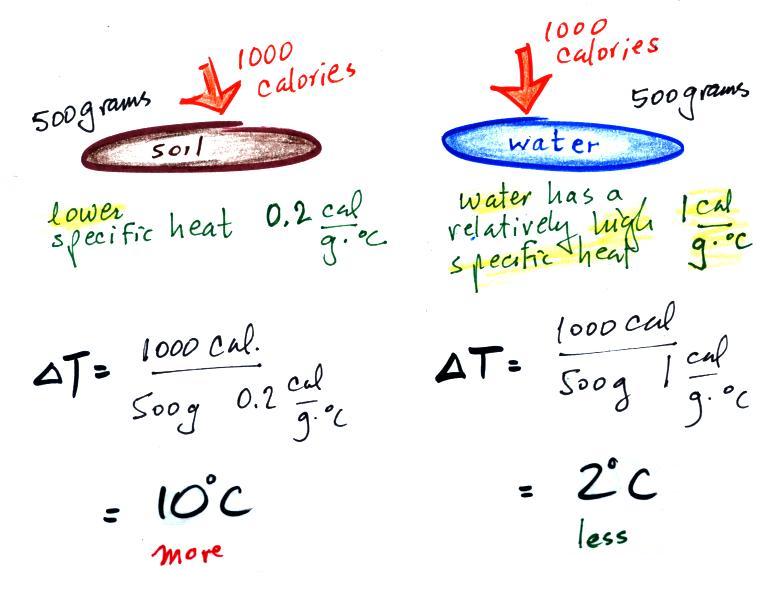Tuesday Feb. 21, 2012
click here to
download today's notes in a more printer friendly format
A couple of songs from Alison Krauss to start the new week.
You heard "Dimming of the Day"
and "Sister
Rosetta
Goes
Before Us".
Quiz #1 has been graded and was returned in class today.
Please
check carefully to see that your quiz was graded correctly and hang on
to this quiz and any other work that is returned to you during the
semester. Don't throw anything away until you've received and
agree with your final grade at the end of the semester.
A couple of assignments are available for your consideration
(neither is required). The
due date for the first one,
a Surface
weather map analysis, has been extended until Tuesday Feb.
28. You can earn up to 5 1S1P pts. The second
is an upper level chart Optional
Assignment due at or before the start of class on Thursday, Mar.
1. You can earn 0.5 pts of extra credit and a green card
(if you answer 85% of the questions correctly) on the second assignment.
To provide some background for the weather map analysis assignment
we'll locate the cold front on the following weather map.
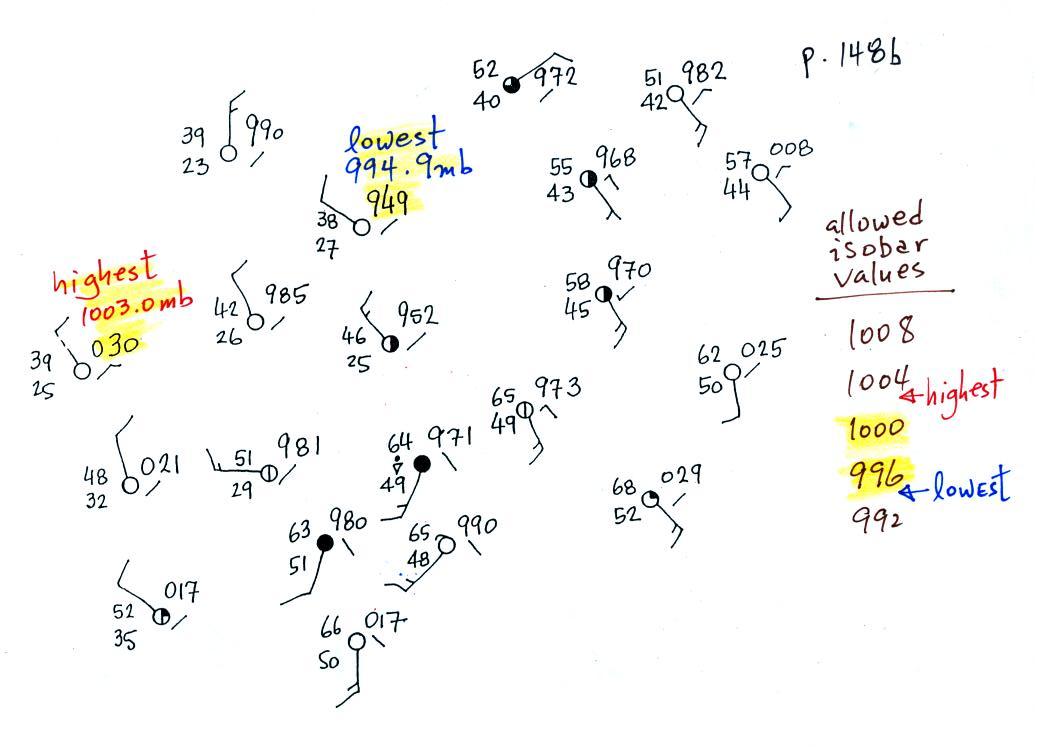
Before trying to locate a cold front, we needed to draw in a few
isobars and map out the pressure pattern. Fronts
are like spokes on a wheel - they rotate counterclockwise around
centers of low pressure. It makes sense to first determine the
location of the low pressure center.
Isobars are drawn at 4 mb increments above and below a starting value
of 1000 mb. Some
of the allowed values are shown on the right side of the figure (992,
996, 1000, 1004, 1008 etc).
The highest actual pressure on the map is 1003.0 mb, the lowest is
994.9
mb. You must choose from the allowed list of isobar values and
pick only the values that fall between the high and low pressure values
on the map. Thus we need to draw in 996 mb and 1000 mb
isobars (you can get a better idea of how to actually draw in the
isobars by looking at the 1S1P Bonus
Assignment Surface Weather Map Analysis Example.
The isobars have been drawn in on the map below.

The cold front has been drawn in at the advancing edge of the cold
air. Note
how
the
cold
front
is
positioned
at the leading edge of the cold air mass, not necessarily in
front of the coldest air in the cold air mass.
3
of
the
stations
from
the
bottom
portion of the map have been redrawn
below.
We need to look at some of the other weather changes to see if the
placement of the front looks reasonable.
The air behind a cold front is usually drier than the air ahead of
the front. This seems to be the case above. Dew points
ahead of the front are in the upper 40s/lower 50s. Behind the
front dew points are in the upper 20s/lower 30s.
There is a clear change in wind direction. Southwesterly
winds found ahead of the front become northwesterly winds behind the
front.
Finally pressures ahead of the front are falling, pressure behind
the front is rising.
Before we go on and have a brief look at a warm front, here's time
lapsed video of last
week's cold front. (it may take some time to download the
video and you may not see the play, pause, and stop buttons at the
bottom of the image)
Warm fronts are found at the boundary between an
advancing warm air mass that is overtaking the retreating back edge of
a cold air mass. This is show below
The back edge of the cold mass has a much different shape than
the advancing edge. The advancing edge bunches up and is
blunt. The back edge gets stretched out and has a ramp like
shape. The warm air rises more slowly and rises over a much
larger area out ahead of the warm front. This is an important
difference between warm and cold fronts. Much more extensive
cloudiness is found out ahead of a warm front that a cold front.
With the extensive and varied mix of clouds comes some very different
types of precipitation (snow, sleet, freezing rain, rain etc).
And the weather
changes found in advance of and following the frontal
passage.
Weather
Variable
|
Behind
(after)
|
Passing
|
Ahead
(before)
|
Temperature
|
warmer
|
|
cool
|
Dew point
|
may be moister
|
|
drier
|
Winds
|
SW, S, SE
|
|
from the East or SE
|
Clouds, Weather
|
clearing
|
|
wide variety of clouds that
may precede arrival of the front by a day or two
clouds may produce a wide variety of types of precipitation also
(snow, sleet,
freezing rain, and rain)
|
Pressure
|
rising
|
minimum
|
falling
|
We didn't try to locate a warm front on a
surface weather, but I promised I would put that on the online
notes. Here's the surface map data that we will be working with
(p. 149b in the ClassNotes)
We'll start by drawing some isobars to map out the pressure
pattern. A partial list of allowed isobars is shown at the right
side of the map above (increments of 4 mb starting at 1000 mb).
We've located located the highest
and lowest pressure values on the map. Then we choose allowed
isobar values that fall between these limits. In this case we'll
need to draw 992 mb and 996 mb isobars.
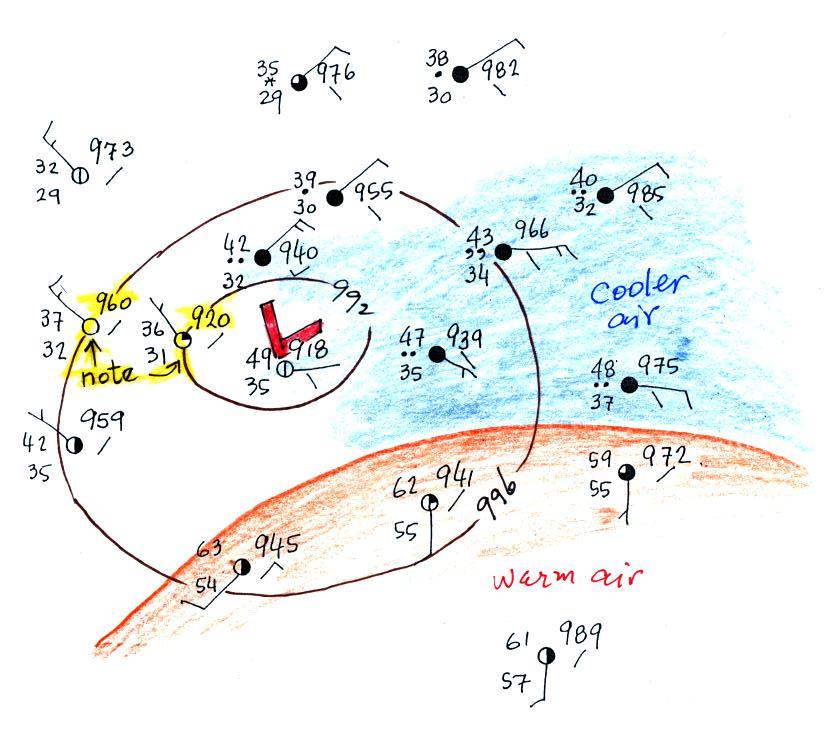
Note that the 992 and 996 mb
isobars each went through a station with pressures of exactly 992.0 and
996.0 mb (highlighted in yellow). The warm air mass has been
colored in orange. Cooler air east of the low pressure center is
blue. Can you see where the warm front should go?

The station north of the front has cooler and drier air, winds are
from the east, skies are overcast and light rain is falling. The
pressure is falling as the warm front approaches. These are all
things you'd expect to find ahead of a warm front. Behind the
front at the southern station pressure is rising, the air is warmer and
moister, winds have shifted to the south and the skies are starting to
clear.
Here's the picture again with something more drawn in.
There's pretty good evidence of a cold front on the left portion
of the map.
One last picture, we go back to the map on p. 39 in the ClassNotes.
One of the questions we had was what might be causing the clouds,
rain, and drizzle in the northeastern part of the country, and the rain
shower along the Gulf Coast. The cold front is almost certainly
the cause of the rain shower and much of the wet weather in the NE is
probably being caused by the warm front.
Up to this point we've been learning about surface weather
maps. Maps
showing conditions at various altitudes above the ground are also
drawn.
Upper level conditions can affect the development and movement of
surface
features (and vice versa). We covered some of the basic concepts
in the next 1/3 of the period. Some additional
supplementary information is available online.
This
supplementary
reading
is
what you'll need to look at if you are
going to try to do the newest Optional Assignment.
Here we'll mostly
just learn 3 basic facts about upper level
charts.
First the overall appearance is somewhat different from a surface
weather
map. The pattern on a surface map can be complex and you
generally find circular (more or less)
centers
of high and low pressure (see the bottom portion of the figure
below). You can also find closed high and low
pressure
centers at upper levels, but mostly you find a relatively simple wavy
pattern like is shown on the upper portion of the figure below (sort of
a 3-dimensional view). You'll find this basic picture on p. 41 in
the ClassNotes.
A simple upper level
chart pattern is sketched below (a map view). There are two basic
features:
wavy lines that dip southward and have a "u-shape" and lines that bend
northward and have an "n-shape".

The u-shaped
portion of the pattern is called a trough. The n-shaped portion
is called
a ridge.

Troughs
are
produced
by
large
volumes
of
cool
or
cold
air
(the
cold
air
is
found
between
the
ground
and
the
upper
level
that
the
map
depicts). The western half of the country in the map above would
probably
be experiencing colder than average temperatures. Large volumes
of warm
or hot air produce ridges. We'll see why this is true in "Upper
level charts pt. 2".

The
winds on upper level charts blow parallel to the contour lines
generally from west to east. This is a little different from
surface winds which blow across the isobars toward low pressure.
An example of surface winds is shown below.

That's it for this first
section. Really all you need to be able to do is
1. identify troughs and ridges,
2. remember that troughs are associated with cold air & ridges with
warm air, and
3. rember that upper level winds blow parallel to the contour lines
from west to east.
Here's the earlier picture again overlaying surface and
upper-level maps.

On
the surface map above you see centers of HIGH and LOW pressure.
The
surface low
pressure center, together with the cold and warm fronts, is a middle
latitude
storm.
Note how the counterclockwise winds spinning around the LOW move warm
air
northward (behind the warm front on the eastern side of the LOW) and
cold air
southward (behind the cold front on the western side of the LOW).
Clockwise winds spinning around the HIGH also move warm and cold
air. The
surface winds are shown with thin brown arrows on the surface map.
Note the ridge and trough features on the upper level chart. We
learned
that warm air is found below an upper level ridge. Now you can
begin to
see where this warm air comes from. Warm air is found west of the
HIGH
and to the east of the LOW. This is where the two ridges on
the
upper level chart are also found. You expect to find cold air
below an
upper level trough. This cold air is being moved into the middle
of the
US by the northerly winds that are found between the HIGH and the
LOW.
Note the yellow X marked on the upper level chart directly above the
surface
LOW. This is a good location for a surface LOW to form, develop,
and
strengthen (strengthening means the pressure in the surface low will
get even
lower than it is now. This is also called "deepening"). The
reason for this is that the yellow X
is a
location where there is often upper level divergence. Similary
the pink X
is where you often find upper level convergence. This could cause
the
pressure in the center of the surface high pressure to get even
higher. You can read more about this in Upper level charts pt. 3.
.

One of the things we have learned about surface LOW
pressure is that
the
converging surface winds create rising air motions. The figure
above
gives you an idea of what can happen to this rising air (it has to go
somewhere). Note the upper level divergence in the figure: two
arrows of
air coming into the point "DIV" and three arrows of air leaving (more
air going out than coming in is what makes this divergence). The
rising
air can, in effect, supply the extra arrow's worth of air.
Three arrows of air come into the point marked "CONV" on the upper
level chart and two leave (more air coming in than going out).
What
happens to the extra arrow? It sinks, it is the source of the
sinking air
found above surface high pressure.
During the next couple of weeks we
will be moving into a completely different topic and will be concerned
with energy,
temperature, heat, energy transport, and
energy
balance between the earth, atmosphere, and space.
It is easy to
lose sight of the main concepts because there are so many
details. Most of the following figures are found on pps 43&44
in the photocopied
ClassNotes.
Types
of
energy
We will learn the names of several
different types or forms of
energy.
Kinetic energy is energy of motion. Some examples (both large
and microscopic scale) are mentioned
and sketched above. This is a relatively easy to visualize and
understand form of energy.

Latent heat energy is perhaps the most
underappreciated and most
confusing type of energy. The word latent refers to energy that is
hidden in water and water vapor. The hidden energy emerges when
water vapor condenses or water freezes (the energy had been added
earlier when ice was melted or water was evaporated).
Radiant energy is a very important form of energy that was for
some
reason left off the original list in the ClassNotes. Sunlight is
an example of
radiant energy that we can see and feel (you feel warm when you stand
in sunlight). There are many types of radiant energy
that are invisible (such as the infrared light that people emit).
Electromagnetic radiation is another name for
radiant energy.
Energy
transport
Four energy transport
processes are listed below.
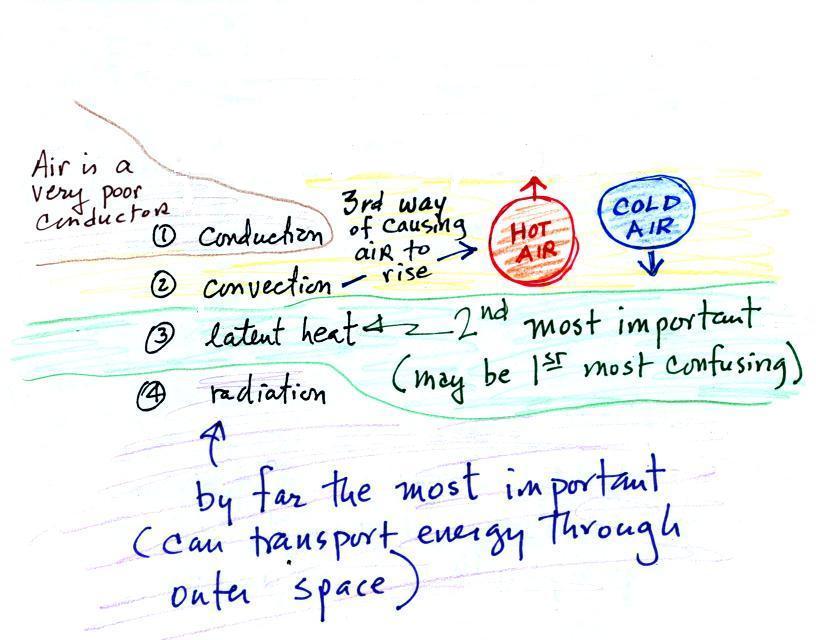
By far the
most important process is at the bottom of the list above. Energy
transport in the form of
electromagnetic radiation (sunlight is a common
form of electromagnetic radiation) is the
only process that can transport energy through empty space.
Electromagnetic radiation travels both to the earth (from the sun) and
away from the earth back into space. Electromagnetic radiation is
also
responsible for about 80% of the
energy transported between the ground and atmosphere.
You might be
surprised to learn that latent heat is the second most important
transport process.
Rising parcels of warm air and sinking parcels of cold air are
examples of free convection. Because of convection you feel
colder or
a cold windy day than on a cold calm day.
Ocean currents are also an example of convection. Ocean currents
transport energy from the warm tropics to colder polar regions.
Convection is a 3rd way of causing rising air
motions in the atmosphere (convergence
into centers of low pressure and fronts are other 2 ways we've
encountered so far)
Conduction is the least important energy transport at least in the
atmosphere. Air is such a poor conductor of energy that it is
generally considered to be an insulator.
Energy
balance
and the
atmospheric greenhouse effect
The next picture
(the figure in the ClassNotes has been split into three
parts for improved clarity) shows energy being transported from the sun
to
the earth in the form of electromagnetic radiation.
We are aware of this energy because
we can see it (sunlight
also contains invisible forms of light) and feel it. With all of
this energy arriving at and
being
absorbed by the earth, what keeps the earth from getting hotter and
hotter? If you park your car in the sun it will heat up.
But there is a limit to how hot it will get. Why is that?
It might be helpful when talking about energy balance to think of a
bank account. If you periodically deposit money into your account
why doesn't the balance just grow without limit. The answer is
that you also take money out of the account and spend it. The
same is true of energy and the earth. The earth absorbs incoming
sunlight energy but also emits energy back into
space (the orange and pink arrows in the figure below)

Energy is emitted in the form of
infrared light is an
invisible form of energy (it is weak enough that we
don't usually feel it either). A balance
between incoming and outgoing energy is achieved and the earth's annual
average temperature remains constant.
We will also look closely at energy transport between the earth's
surface and the atmosphere (see the figure below). This is where latent
heat energy transport,
convection and conduction operate (they can't transport energy beyond
the atmosphere and into outer space).
That
is
also
where
the
atmospheric
greenhouse functions. That will be a important goal -
to
better understand how the atmospheric greenhouse effect works.
The greenhouse effect is getting a
lot of "bad press". If the earth's atmosphere didn't contain
greenhouse gases and if there weren't a greenhouse effect, the global
annual average surface temperature would be about 0 F (scratch out -4 F
and put 0 F, it's easier to remember). Greenhouse gases raise
this
average to about 60 F and make the earth a much more habitable
place. That is the beneficial side of the
greenhouse effect.
The detrimental side is that atmospheric greenhouse gas concentrations
are increasing. This might enhance or strengthen the greenhouse
effect and
cause the earth to warm. While that doesn't necessarily sound bad
it could have many unpleasant side effects. That's a subject
we'll explore briefly later in the semester.
When you
add energy to an object, the object will usually
warm
up (conversely when you take energy from an object the object will
cool). It is relatively easy to come up with an equation that
allows
you to figure out what the temperature change will be (one of those
equations I'll probably write on the board during the next quiz if you
ask me to - try
to understand it, you don't have to memorize it).
The temperature change, ΔT, will
first depend on
how much energy was added, ΔE. This is a
direct proportionality, so ΔE is in the
numerator of the
equation (ΔE and ΔT are
both positive when energy is added,
negative when energy is removed)
When you add equal amounts of energy to large and small pans
of water, the small pan will heat up more
quickly. The temperature change, ΔT, will
depend on the
amount of water, the mass. A small mass will mean a large ΔT,
so
mass
should
go
in
the
denominator
of the equation.
Different materials
react differently when energy is added to them. A material with a
large specific heat will warm more slowly than a material with a small
specific heat. Specific heat has the same kind of effect on ΔT
as
mass. Specific heat is sometimes called "thermal mass" or
"thermal capacity." You can think of specific heat as
being thermal inertia - a substance with high specific heat, lots of
thermal inertia, will be reluctant to change temperature.
Here's an important example that will show the effect of specific
heat (middle of p. 45). I've changed the numbers from the example
shown in class.
Equal
amounts of energy (1000 calories, note that calories are units of
energy) are added to
equal masses (500 grams) of water and soil. We use water and soil
in the
example because most of the earth's surface is either ocean or land.
Before we do the calculation, try to guess which material will warm up
the most. Everything is the same except for the specific
heats. Will water with its 5 times larger specific heat warm up
more or less than the water?
Here are the details of the calculation.
With its higher specific heat, the water doesn't heat up nearly as
much as the soil. If we had been removing energy the soil would
have cooled off more than the water also.
These different rates of warming of water and soil have
important effects on regional climate.
Oceans moderate the climate.
Cities near a large body
of water won't warm as much in the summer and won't cool as much during
the winter compared to a city that is surrounded by land.
The yearly high and low monthly average temperatures are shown at
two locations above. The city on the
coast has a 30o F annual range of temperature (range is the
difference between the summer and winter temperatures). The
city further
inland (assumed to be at the same latitude and altitude) has an annual
range of 60o F. Note that both cities have the same 60o
F annual
average temperature. We'll see a much more dramatic example of
the moderating effect of water on climate in a couple of weeks.
Here's another situation where you
can take advantage of water's
high specific heat to moderate "micro climate."
I did plant
some of my young tomato plants last weekend (this is a picture from a
previous year). It
still
can get
plenty cold enough at night in February or early March to kill tomatoes
(the brocolli
and lettuce in the background can handle a
light frost) so you have to protect them.
Here's one way of doing that.
You
can
surround
each
plant
with
a
"wall
o
water"
-
a teepee
like arrangement that surrounds each plant. The cylinders are
filled with water and they take advantage of
the high specific
heat of water and won't cool as much as the air or soil would during a
cold
night. The walls of water produce a warm moist microclimate that
the tomato seedlings love. The plastic is transparent so plenty
of sunlight can get through.



